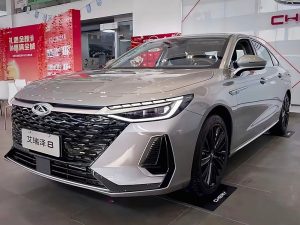Chinese cars have become the top sellers in Ecuador, skyrocketing from a 10 percent market share in 2018 to over 30 percent and rising today. El Universo newspaper reports that 47 of 107 auto brands currently available in Ecuador are Chinese. Chery is the most popular, followed by Great Wall, DFSK, and JAC.
“The Chinese cars are cheaper. They helped people get through the pandemic. But they deteriorate rapidly,” Uber driver Marcelo Vicente told me as we cruised through downtown Quito on a balmy Sunday afternoon. Vicente drives a Hyundai SUV, because “Hyundais and Chevrolets last longer,” he said.
But this stereotype of low-quality Chinese cars is dissolving fast in Ecuador. “Until a few years ago, Chinese cars had a bad name here, because spare parts were not sufficiently available,” said Johan Klok, a Dutch expat living in Quito. “But this has changed drastically. The Chinese have developed a good network of repair shops, the designs are looking great, and the quality is good.
“It’s an even better story for Chinese electric vehicles. These cars easily surpass competing European models.”
In the upscale Mall del Sol in Guayaquil, Ecuador’s main port and largest city, a fully electric, gleaming silver BYD Yuan SUV stands roped off from spectators. BYD stands for “Build Your Dreams,” and it is the largest EV maker in China, and second in the world only to Tesla.
In Bogotá, Colombia, Uber driver Henry Rojas drives a BYD Yuan. “I drive it fourteen hours a day sometimes, with no problems,” he said.
BYD is making moves in Bogotá in a big way. It sold the city 379 electric buses, which began operating in 2020. This gave Bogotá the second-largest electric bus fleet among South American cities after Santiago, Chile – and BYD provided 60 percent of the city’s electric buses, the highest number in any city the world outside China. BYD electric buses can also be found in Argentina, Brazil, and Uruguay.
Affordability has played a leading role in the global ascent of Chinese vehicles – especially in Ecuador, where some 35 percent of 18 million citizens live on less than $5.50 per day. Among the cheapest Chinese imports is the state-owned brand Chery, which sells in Ecuador starting around $15,000. And the Chang Li S1 Pro, often considered the world’s cheapest car, sells for around $3,500.
Ecuador is also fast becoming a hotspot for assembling Chinese vehicles. Great Wall Motor (GWM) launched an assembly plant in Ecuador in 2013, which began exporting vehicles to Colombia and Costa Rica in 2019. In 2017, BYD signed a deal with Ecuador’s government to build an electric bus assembly plant, which will produce 300 buses per year. Then in 2019, BYD built a $600,000 EV charging station in Guayaquil nicknamed “la electrolinera,” which can charge a car in 90 minutes and a bus in 3.5 hours. And in 2020, Guayaquil imported Ecuador’s first 20 electric buses from BYD.
China’s high EV production is another driver of its rapid rise in auto exports to the Americas. EVs have high growth potential in Latin America, where many countries have proposed or initiated policies to transition public bus fleets to EVs and cut taxes for EVs. In Brazil, for example, the import tariff is 35 percent on combustion cars but 0 percent on EVs. And in one of the most drastic emissions restrictions in the Americas, in 2021 Chile announced that starting in 2035 it will ban the sale of nearly all vehicles that do not have zero carbon emissions. Such policies aim to reduce not only greenhouse gases but Latin America’s generally heavy urban pollution, which is due in part to relatively low vehicle emission standards and high photochemical smog resulting from extreme incoming UV rays in the region’s many high-elevation cities, like Mexico City, La Paz, Quito, Medellín, and Bogotá.
China became the world’s largest car exporter this year, overtaking Japan. While no Chinese car brands are sold in the United States, they have gone from near-zero market share to 11 percent in Australia, 8 percent in South Africa, and 7 percent in Spain. This rise of Chinese vehicles globally comes as sales of U.S. and German cars are plummeting in China, the largest car market in the world. Meanwhile, Chinese vehicles are on the rise inside China, where they are projected to take a majority share for the first time later this year.
Today about a third of cars on the road in China are electric. And boosted by heavy government subsidies for EV manufacturing, China now produces over 50 percent of all EVs worldwide, with models running from $11,000 to $160,000. As much of the world ponders a slow transition toward EVs, more EVs are sold in China than in the rest of the world combined, giving China a massive domestic laboratory to improve EV exports. Worldwide, BYD shipped over 100,000 more EVs than Tesla in the first quarter of 2023, and it aims to overtake Tesla in global sales of EVs later this year.
Thus while Chinese automakers try to catch up to established brands in global exports, it seems clear that in EVs, the world will soon be trying to catch up to China.

































